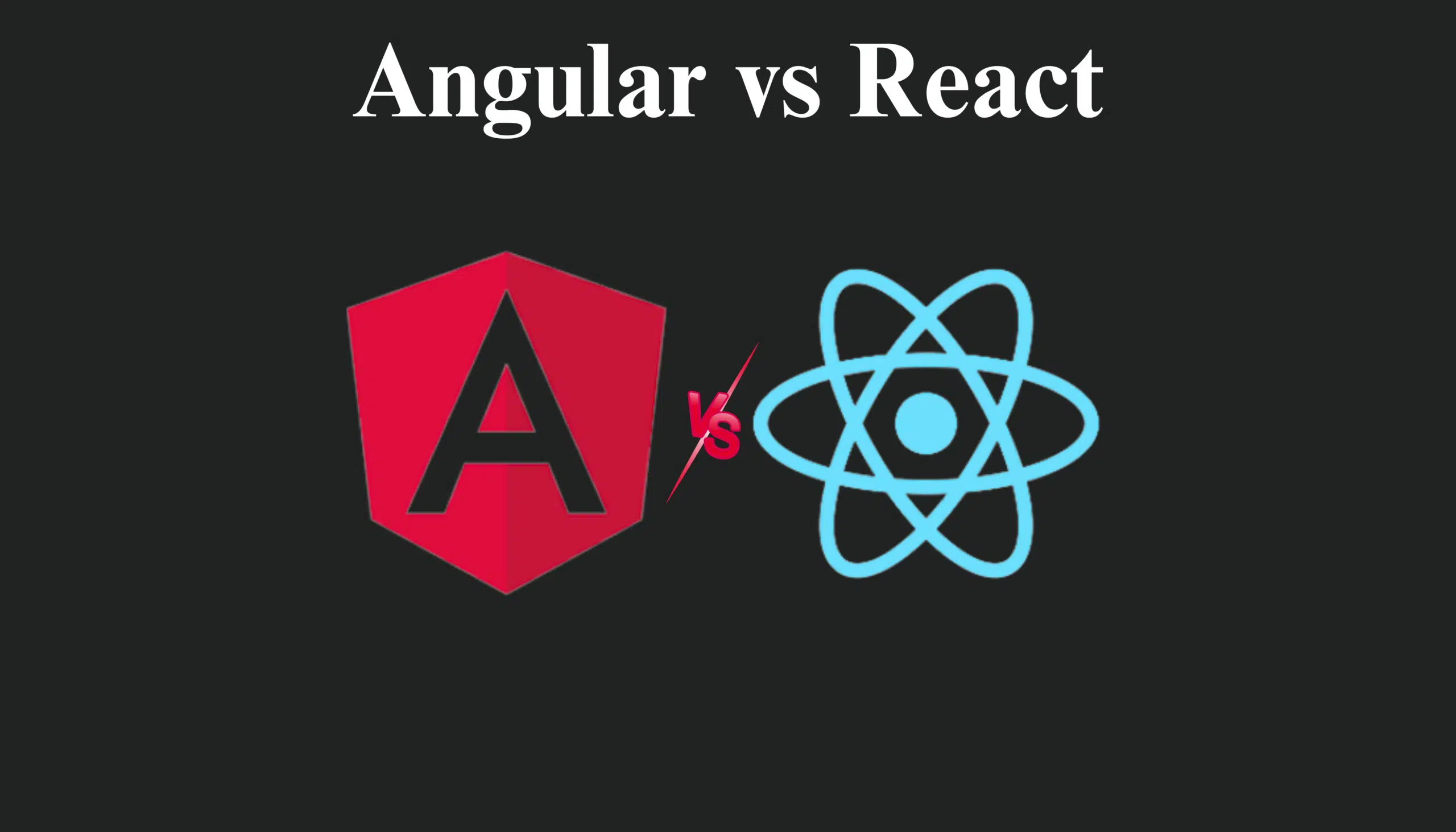Angular vs React
In the fast-evolving landscape of web development, choosing the right front-end framework is crucial for building efficient, scalable, and high-performing applications. Among the most popular choices, Angular and React stand out as leading technologies, each offering unique advantages. While Angular, developed by Google, is a full-fledged framework known for its robust structure and two-way data binding, React, maintained by Meta (formerly Facebook), is a flexible library favored for its component-based architecture and virtual DOM.
The debate over “Angular vs React” continues to dominate discussions in the development community. Businesses and developers must carefully evaluate their project requirements, scalability needs, and performance expectations before making a choice. Both technologies are widely used in enterprise and consumer applications, from large-scale platforms like Google Ads (Angular) to social media giants like Facebook (React).
This article provides an in-depth, feature-by-feature comparison of Angular and React, covering their architectures, performance, scalability, learning curves, and real-world applications. By the end, you’ll have a clear understanding of which technology best suits your project in 2025 and beyond. Let’s dive into the details of Angular vs React to help you make an informed decision.
Hire the Best Angular & React Developers
Understanding Angular and React
What is Angular?
Angular is a powerful, full-fledged front-end framework developed and maintained by Google. Originally released as AngularJS in 2010, it was later rewritten from scratch in 2016 as Angular 2+, commonly referred to simply as Angular. Unlike its predecessor, modern Angular follows a component-based architecture, making applications more modular and scalable.
Key Features of Angular
- TypeScript-Based: Angular is built using TypeScript, a superset of JavaScript that enhances code maintainability, scalability, and error detection.
- Two-Way Data Binding: It synchronizes data between the model and the view, reducing the need for manual DOM manipulation.
- Modular Architecture: Uses modules (NgModules) to organize and manage different functionalities efficiently.
- Dependency Injection: Helps manage application dependencies, making components more reusable and testable.
- Built-in Routing & State Management: Provides a robust routing system and supports state management with tools like NgRx.
- High Performance with Ivy Renderer: Angular’s Ivy rendering engine improves speed, reduces bundle size, and enhances debugging.
- Comprehensive CLI: The Angular CLI simplifies project creation, configuration, and deployment.
Latest Angular Updates (2025)
The latest version of Angular (Angular 17) brings several improvements, including standalone components, declarative control flow, and enhanced hydration for server-side rendering (SSR), making it even more efficient for large-scale applications.
What is React?
React is a flexible, high-performance JavaScript library developed by Meta (formerly Facebook). It was introduced in 2013 to simplify the process of building dynamic user interfaces. Unlike Angular, React focuses solely on the view layer (UI rendering), making it more lightweight and adaptable for integrating with other libraries or frameworks.
Key Features of React
- Component-Based Architecture: Applications are structured using reusable, self-contained components.
- Virtual DOM for Faster Rendering: React uses a virtual DOM to update only the necessary parts of the UI, improving performance.
- One-Way Data Binding: Ensures predictable state management, making debugging easier.
- JSX (JavaScript XML): Allows developers to write HTML-like syntax inside JavaScript, making UI development more intuitive.
- Hooks for State Management: React introduced Hooks (useState, useEffect, etc.) to simplify state and lifecycle management without using class components.
- Strong Ecosystem: React integrates well with tools like Redux, Recoil, or Context API for advanced state management.
- React Native for Mobile Development: React’s ecosystem extends beyond web applications, enabling developers to build cross-platform mobile apps using React Native.
Latest React Updates (2025)
The latest React version (React 19) introduces React Server Components (RSC), improved hydration for SSR, and optimizations for concurrent rendering, making it even more efficient for large-scale and interactive applications.
Both Angular and React continue to dominate front-end development, but their differences in architecture, performance, and use cases make them suitable for different kinds of projects. Up next, let’s dive deeper into their key differences to help you determine which one best fits your needs.
Build Your Scalable Web App Today
Key Differences Between Angular and React
Architecture and Structure
One of the fundamental differences between Angular and React lies in their architectural approach.
Angular: Full-Fledged MVC Framework
Angular follows the Model-View-Controller (MVC) architecture, offering a comprehensive framework for developing large-scale enterprise applications. It provides built-in tools for:
- Routing (Angular Router)
- State management (NgRx)
- Dependency injection (DI)
- Templating and forms handling
This structured approach makes Angular an ideal choice for complex enterprise solutions, but it comes with a steeper learning curve.
React: Lightweight Component-Based Library
React, on the other hand, is a view layer library rather than a full-fledged framework. It follows a component-based architecture, allowing developers to build applications with modular, reusable UI components. However, React requires additional third-party libraries (like Redux for state management, React Router for navigation) to match Angular’s built-in features.
Learning Curve and Setup
- Angular: Requires knowledge of TypeScript, RxJS, and Angular CLI. The initial setup involves configuring modules and dependencies.
- React: Easier to learn for beginners, with a simpler setup that only requires basic JavaScript and JSX knowledge.
Verdict: If you need a complete, scalable solution with an opinionated structure, go for Angular. If you prefer a lightweight, flexible UI library with more customization freedom, choose React.
Language and Syntax
Angular: TypeScript for Scalability
Angular is built with TypeScript, a statically typed superset of JavaScript that improves code maintainability and error detection during development.
Pros:
✅ Strong typing for large-scale applications
✅ Better tooling and auto-completion
✅ Helps prevent runtime errors
Cons:
❌ Steeper learning curve for developers new to TypeScript
❌ More boilerplate code compared to JavaScript
React: JavaScript and JSX for Flexibility
React primarily uses JavaScript and JSX (JavaScript XML), allowing developers to write HTML-like code within JavaScript. JSX simplifies UI creation, making it more readable and maintainable.
Pros:
✅ Easier for JavaScript developers to adopt
✅ JSX makes UI code more intuitive
✅ Less restrictive and allows functional programming
Cons:
❌ Lacks the static typing advantages of TypeScript (unless TypeScript is used with React)
❌ May lead to runtime errors without strong type checking
Verdict: If strict type checking and scalability are essential, go for Angular. If you prefer flexibility and ease of use, React is a better choice.
Data Binding
Data binding is a key factor in determining how UI components interact with data sources in an application.
Angular: Two-Way Data Binding
Angular’s two-way data binding automatically synchronizes the model and the view. Any change in the UI is reflected in the underlying data model, and vice versa.
Pros:
✅ Reduces manual updates
✅ Simplifies form handling and state management
Cons:
❌ Can impact performance in large applications due to frequent DOM updates
React: One-Way Data Binding
React uses one-way data binding, meaning the data flows in a single direction—from the component’s state to the UI. This makes state changes more predictable and manageable.
Pros:
✅ Improves application performance by reducing unnecessary re-renders
✅ Easier to debug and test
Cons:
❌ Requires manual state updates using React’s useState or Redux for complex state management
Verdict: React’s one-way binding makes it more efficient and predictable, whereas Angular’s two-way binding simplifies data updates but can be performance-intensive in large apps.
Performance and Speed
Angular: Real DOM and Heavy Initial Load
Angular uses a real DOM, which updates the entire structure when a change occurs. However, with Ivy Renderer, Angular has optimized change detection, making it faster than before.
Performance factors:
- Heavier initial bundle size compared to React
- Slower DOM manipulation due to real DOM updates
- Efficient for enterprise-level apps that require a structured framework
React: Virtual DOM for Fast Rendering
React’s virtual DOM improves performance by updating only the changed components instead of re-rendering the whole UI.
Performance factors:
- Faster rendering and updates due to the virtual DOM
- Efficient for dynamic applications with frequent UI updates
- Better for real-time applications like chat apps or social media platforms
Verdict: React outperforms Angular in speed due to its lightweight nature and virtual DOM, whereas Angular can be optimized for performance with lazy loading and Ahead-of-Time (AOT) compilation.
Get a Custom Angular/React Solution
Popularity and Market Demand
The adoption of Angular and React continues to shape the modern web development landscape. Their popularity is influenced by job market demand, developer community support, and ecosystem maturity.
Current Market Trends
Job Market Demand for Angular and React Developers
The job market for both Angular and React developers remains strong, with a significant demand in the enterprise and startup sectors.
- React dominates front-end job postings, especially in startups and product-based companies due to its flexibility and ease of integration.
- Angular remains the go-to choice for large-scale enterprise applications, often preferred by government agencies, banking systems, and corporate IT departments.
According to Stack Overflow’s Developer Survey 2024:
- React ranks among the top 3 most-used web frameworks worldwide.
- Angular remains in the top 5, preferred for full-fledged applications requiring built-in solutions.
- React developers have higher hiring potential, as React is often used alongside frameworks like Next.js, making it a more versatile skill.
Popularity Metrics and GitHub Stars
Looking at GitHub statistics (as of 2025):
- React: Over 215k GitHub stars, with thousands of contributors actively maintaining it.
- Angular: Over 95k GitHub stars, backed by Google with long-term enterprise support.
- NPM package downloads: React consistently sees higher weekly downloads than Angular, reflecting broader adoption.
Both technologies have a strong presence, but React’s higher adoption rate in new projects gives it a slight edge in market demand.
Community Support and Ecosystem
- A strong developer community and ecosystem contribute to the longevity and scalability of a framework. Both Angular and React have thriving communities, but their support structures differ.
Angular: A Robust but Structured Community
Angular has an official and centralized ecosystem maintained by Google.
- Dedicated long-term support from Google for enterprise users.
- Large-scale conferences like ngConf keep developers updated on advancements.
- Built-in solutions for routing, forms, and state management reduce reliance on third-party tools.
However, Angular’s steeper learning curve means that fewer beginner-friendly resources exist compared to React.
React: A Massive and Decentralized Community
React benefits from a vast, open-source ecosystem maintained by Meta and thousands of contributors worldwide.
- Millions of developers worldwide, making it easy to find support.
- React-focused events, including React Conf and React Summit.
- Thousands of third-party libraries for UI components, routing (React Router), and state management (Redux, Recoil).
While React lacks built-in solutions for things like routing and dependency injection, its huge ecosystem of third-party plugins offers flexibility.
Verdict:
- Angular is best for developers seeking a structured framework with official support.
- React is better for those who prefer flexibility and access to a huge open-source community.
Both frameworks continue to thrive, but React’s wider adoption and active third-party ecosystem give it a competitive edge in popularity and market demand.
Use Cases and Real-World Applications
When choosing between Angular and React, understanding their ideal use cases and real-world applications can help determine which technology is best suited for a specific project.
When to Use Angular
Ideal Projects and Industries
Angular is well-suited for large-scale, enterprise-grade applications where built-in features like routing, dependency injection, and state management are beneficial. Industries that typically prefer Angular include:
- Enterprise and Corporate Software (ERP, CRM, HRM systems)
- Healthcare Applications (EHR/EMR systems, patient portals)
- Banking & Financial Platforms (Secure transactions, dashboards)
- Government and Public Sector Websites (Robust security and maintainability)
- Multi-User Collaboration Tools (Project management, workflow automation)
Case Studies: Companies Using Angular
Several well-known organizations rely on Angular to build and maintain their complex applications:
- Google Ads: Angular’s framework handles complex UI interactions efficiently.
- Microsoft Office 365: Uses Angular for web-based applications.
- Forbes: The high-traffic publishing platform leverages Angular for performance optimization.
- Gmail: Angular powers Google’s web-based email client.
Angular’s structured framework and built-in solutions make it a great choice for organizations that require scalability, maintainability, and long-term support.
When to Use React
Ideal Projects and Industries
React is ideal for dynamic, high-performance applications with frequent UI updates. It excels in:
- Single Page Applications (SPAs) (Real-time dashboards, e-commerce platforms)
- Social Media Platforms (News feeds, interactive UI elements)
- Startups and MVPs (Fast iteration, ease of scaling)
- Streaming and Media Applications (Video streaming, gaming interfaces)
- Cross-Platform Mobile Apps (Using React Native)
Case Studies: Companies Using React
Many tech giants and startups leverage React’s component-based flexibility:
- Facebook: React was originally developed for Facebook and powers its UI.
- Instagram: Uses React for seamless social interactions.
- Netflix: React optimizes performance in low-bandwidth environments.
- Airbnb: React enables dynamic updates and interactive search functionality.
React’s lightweight architecture and virtual DOM make it an excellent choice for projects requiring flexibility, real-time interactions, and smooth performance.
Boost Your Business with Expert Development
Comparative Case Study: Angular vs React in Real-World Projects
Example Project: Building an E-Commerce Platform
Imagine a company developing a large-scale e-commerce platform with advanced search, real-time product updates, and secure payment integration.
🏆 Using Angular:
- A structured, modular framework helps manage complex UI components.
- Two-way data binding ensures seamless interaction between the cart, product page, and checkout.
- Built-in security and form validation make it easier to implement authentication.
🚀 Using React:
- The virtual DOM ensures high-speed performance with real-time UI updates.
- One-way data binding improves maintainability and debugging.
- React’s component reusability allows for a highly customizable and interactive shopping experience.
Performance, Scalability, and Development Speed
Factor | Angular | React |
Performance | Good, but can be slower due to real DOM updates | Faster due to virtual DOM |
Scalability | Ideal for large-scale applications with complex logic | Scales well but requires additional tools for state management |
Development Speed | Slower due to steep learning curve and boilerplate code | Faster for startups and MVPs |
Verdict
- If the project demands a structured approach, security, and scalability, Angular is the best choice.
- If performance, interactivity, and fast development cycles are the priority, React is the better option.
Both Angular and React offer unique advantages, and selecting the right one depends on the project’s complexity, scalability needs, and long-term goals.
Development Experience
When choosing between Angular and React, developers often consider how easy it is to learn, set up, and integrate with other tools. A smoother development experience leads to faster project delivery and better maintainability.
Learning Curve
Time to Proficiency and Resources Available
- Angular has a steeper learning curve due to its opinionated structure, reliance on TypeScript, and concepts like dependency injection, RxJS (Reactive Extensions for JavaScript), and decorators.
- React is more beginner-friendly since it primarily requires knowledge of JavaScript and JSX. Developers can start quickly with React and progressively learn additional tools like React Router, Redux, and Hooks as needed.
Comparison of Documentation Quality
- Angular’s official documentation is well-structured but can be overwhelming due to the vast number of built-in features. However, it provides detailed guides and tutorials, making it easier for experienced developers to understand.
- React’s documentation is more straightforward and concise, allowing developers to get started quickly. The React community also provides extensive third-party learning resources like React.dev, freeCodeCamp, and Udemy courses.
Verdict
- React is easier to learn for new developers and has simpler documentation.
- Angular requires more time to master due to its complex architecture but offers comprehensive learning resources for enterprise-level development.
Tooling and Integration
Overview of CLI Tools, IDE Support, and Third-Party Integration
- Angular CLI (Command Line Interface)
- A powerful built-in CLI for project scaffolding, testing, and deployment.
- Provides predefined configurations, reducing manual setup.
- Integrated with TypeScript, Webpack, and Karma (for testing).
- Supports Angular Material and other UI component libraries.
- React’s Tooling (Create React App & Vite)
- Create React App (CRA) is the standard way to quickly set up a React project with minimal configuration.
- Vite is a faster alternative for lightweight builds with better hot module replacement (HMR).
- React doesn’t come with built-in routing, state management, or testing tools—developers need to install React Router, Redux, and Jest separately.
Benefits and Drawbacks of Angular CLI vs. React Tooling
Feature | Angular CLI | React Tooling |
Ease of Setup | Comes pre-configured with built-in tools | Requires adding third-party libraries |
Performance Optimization | Built-in optimization with AOT (Ahead-of-Time Compilation) | Vite improves build speeds significantly |
Customization | Opinionated structure; less flexibility | More modular and customizable |
Build Speed | Slightly slower due to heavy initial configuration | Faster development speed |
Verdict
- Angular CLI is feature-rich and standardized, making it perfect for large-scale enterprise applications.
- React’s tooling offers more flexibility, allowing developers to choose their own stack based on project needs.
Both frameworks provide excellent tooling and integration, but the choice depends on whether you prefer an all-in-one framework (Angular) or a more flexible ecosystem (React).
Future Prospects
As web development continues to evolve, both Angular and React are actively maintained and updated to enhance performance, scalability, and developer experience. Understanding their roadmaps can help businesses and developers choose the right technology for future-proof applications.
Roadmap for Angular
Upcoming Features and Updates
Google has consistently updated Angular to improve performance, reduce complexity, and enhance developer experience. The latest roadmap for Angular 18 and beyond includes:
- Standalone Components (Further Improvements) – Reducing the need for NgModules, simplifying app structure.
- Signal-Based Reactivity – A major shift to improve state management and performance, making Angular more reactive like React.
- Improved SSR (Server-Side Rendering) and Hydration – Enhancing Angular Universal for better SEO and faster page loads.
- Fine-Grained Lazy Loading – Optimizing module bundling for better load times.
Long-Term Support and Community Roadmap
- Angular’s enterprise-grade support ensures long-term stability, making it a reliable choice for large-scale applications.
- Google continues to invest in backward compatibility while introducing modern reactivity features, keeping Angular competitive with React.
Verdict: Angular is shifting towards a more flexible and modern development approach, making it more appealing for future projects.
Roadmap for React
Upcoming Features and Updates
React’s roadmap for 2025 and beyond focuses on performance optimization, concurrent rendering, and server-side enhancements:
- React Server Components (RSC) – Allowing components to run on the server, reducing bundle size and improving performance.
- Enhanced Suspense for Data Fetching – Making asynchronous rendering more efficient.
- Improved Hydration for SSR – Faster page loads for server-rendered React apps.
- React Compiler – Optimizing component rendering at the build time instead of runtime.
Long-Term Support and Community Roadmap
- React’s strong open-source community ensures continuous innovation.
- Meta (Facebook) actively supports React but encourages developers to use Next.js for SSR and routing.
- React remains the go-to choice for startups, SaaS platforms, and mobile app development.
Verdict: React continues to dominate performance-driven applications, with a clear focus on concurrent rendering and server-side efficiency.
Final Thought on Future Prospects
- Angular is evolving to become more reactive and lightweight, making it better suited for modern development needs.
- React is optimizing for speed, performance, and better SSR, reinforcing its dominance in interactive and real-time applications.
Both frameworks are actively evolving, ensuring long-term relevance in the ever-changing web development landscape.
Pros and Cons
Both Angular and React have their strengths and weaknesses, making them suitable for different types of projects. Below is a detailed analysis of their advantages and challenges to help you make an informed decision.
Pros and Cons of Angular
Pros of Angular
✅ Full-Fledged Framework – Comes with built-in tools for routing, form validation, dependency injection, and state management, reducing the need for third-party libraries.
✅ TypeScript Support – Provides static typing, better debugging, and enhanced code maintainability, making it ideal for large-scale enterprise applications.
✅ Two-Way Data Binding – Simplifies synchronization between the model and the view, reducing manual DOM manipulation.
✅ Enhanced Performance with Ivy Renderer – Angular’s Ivy engine improves compilation speed, reduces bundle size, and optimizes rendering performance.
✅ Strong Google Backing – Ensures long-term support, frequent updates, and compatibility with enterprise solutions.
✅ Modular Structure – Makes it easier to maintain and scale applications.
Cons of Angular
❌ Steeper Learning Curve – Requires developers to learn TypeScript, RxJS, Angular CLI, and dependency injection, making it harder for beginners.
❌ Heavy Initial Bundle Size – Angular applications can be larger compared to React due to the built-in features and framework complexity.
❌ Slower Development Speed – Due to its opinionated structure, setting up an Angular project takes longer than a lightweight library like React.
❌ More Boilerplate Code – Requires writing more code for common tasks, which can slow down development.
Verdict: Angular is best suited for large-scale applications that require structure, maintainability, and built-in features, but it comes with a steep learning curve and heavier bundle size.
Pros and Cons of React
Pros of React
✅ Lightweight and Flexible – Unlike Angular, React is just a UI library, allowing developers to choose their own routing, state management, and third-party tools.
✅ Virtual DOM for Performance – Updates only the changed components, making UI rendering much faster than Angular’s real DOM approach.
✅ One-Way Data Binding – Ensures predictable state management, making debugging easier.
✅ Component Reusability – Encourages modular development, reducing redundancy and improving maintainability.
✅ Strong Community and Ecosystem – A vast open-source community ensures continuous updates, extensive libraries, and a large pool of developers.
✅ Easier to Learn and Set Up – React’s JSX syntax is simple for JavaScript developers, and Create React App (CRA) or Vite allows quick project setup.
✅ React Native for Mobile Development – Allows developers to use the same React knowledge for building cross-platform mobile apps.
Cons of React
❌ Not a Full Framework – Lacks built-in solutions for routing, state management, and dependency injection, requiring third-party libraries like React Router and Redux.
❌ Frequent Updates and Breaking Changes – React’s fast-paced development can introduce breaking changes, requiring developers to constantly adapt.
❌ JSX Can Be Unintuitive for Some Developers – While JSX makes UI development easier, it mixes HTML and JavaScript, which might feel unconventional for developers used to traditional separation.
❌ State Management Complexity – Managing state efficiently often requires additional libraries like Redux, Recoil, or Context API, adding to the learning curve.
Verdict: React is lightweight, flexible, and easier to learn, making it ideal for fast development cycles and high-performance applications, but it lacks built-in features and relies on third-party tools for complete functionality.
Final Comparison
Feature | Angular | React |
Best for | Enterprise apps, complex web platforms | Interactive UIs, startups, SPAs |
Learning Curve | Steep (TypeScript, RxJS, CLI) | Easier (JavaScript, JSX) |
Data Binding | Two-way (easier sync) | One-way (better control) |
Performance | Good, but heavier due to real DOM | Faster with Virtual DOM |
Flexibility | Opinionated framework with built-in tools | More flexible, requires third-party tools |
State Management | Built-in (NgRx, Services) | Requires Redux, Context API, etc. |
Mobile Development | Requires Ionic for hybrid apps | React Native for cross-platform apps |
Community Support | Strong enterprise support | Larger open-source ecosystem |
Both Angular and React have their strengths and weaknesses, and the choice depends on your project requirements. If you need a structured, enterprise-ready framework, go with Angular. If you prefer flexibility, speed, and a lighter setup, React is the better option.
FAQ Section
The primary difference between Angular and React lies in their architecture and purpose. Angular is a full-fledged framework, while React is a lightweight library focused on building user interfaces.
- Framework vs. Library: Angular provides built-in features like routing, state management, form handling, and dependency injection, whereas React requires third-party libraries for these functionalities.
- Data Binding: Angular uses two-way data binding, automatically updating the model and view, whereas React uses one-way data binding, making state management more predictable.
- Performance: React’s virtual DOM makes UI updates faster compared to Angular’s real DOM, which requires additional optimization for large applications.
- Development Experience: React has a shallower learning curve, while Angular’s TypeScript-based architecture and reliance on RxJS for reactive programming make it more complex but structured.
Verdict: Choose Angular if you need a complete, opinionated framework. Choose React if you prefer flexibility and performance optimization.
For large-scale applications, Angular is generally the better choice due to its structured architecture, built-in solutions, and long-term enterprise support.
Angular’s Strengths for Large-Scale Apps:
✅ Modular architecture ensures better code organization.
✅ Dependency injection simplifies component management.
✅ Enterprise-level security and strict TypeScript support prevent runtime errors.
✅ Built-in features like routing, HTTP services, and state management eliminate the need for external dependencies.React’s Suitability for Large Applications:
✅ Virtual DOM ensures high-performance rendering.
✅ Flexibility in choosing state management solutions (Redux, Recoil, etc.).
✅ Next.js enables better server-side rendering and scalability.
However, large-scale React applications often require additional configurations, whereas Angular provides a more streamlined approach for handling complex workflows, security, and scalability.
Verdict: Angular is the preferred choice for large-scale enterprise apps, but React can be a strong contender when paired with Next.js and proper state management.
Yes, it is possible to use Angular and React together, but it is not a common practice due to their architectural differences. However, in certain scenarios, integrating both can be beneficial.
How to Use Angular and React Together
Embedding React Components in an Angular Application:
- React can be used within an Angular app via ReactDOM.render() inside an Angular directive.
- This is useful for gradually migrating legacy AngularJS apps to React.
Using Angular for Core Logic and React for UI:
- Angular can handle business logic, data processing, and routing, while React can be used for interactive UI components.
Challenges of Using Angular and React Together
❌ Increased Complexity – Requires additional configurations for component communication.
❌ Different State Management Approaches – Angular uses services and RxJS, while React relies on Hooks and Context API.
Verdict: While it is possible to combine Angular and React, it is generally better to choose one framework to avoid unnecessary complexity.
Yes, Angular is better suited for enterprise-level applications due to its robust architecture, built-in security, and long-term support from Google.
Why Enterprises Prefer Angular
✅ Strict TypeScript Implementation – Reduces errors and enhances maintainability.
✅ Comprehensive Framework – Includes everything needed for large-scale applications, from routing to form validation.
✅ Better Scalability – Modular structure allows for better code organization and maintainability.
✅ Long-Term Google Support – Ensures that Angular remains relevant with continuous updates.
Where React is Used in Enterprises
While Angular is dominant in enterprise solutions, React is also widely adopted, especially in companies that require high-performance, dynamic UI applications like:
- Netflix (for fast UI rendering).
- Facebook & Instagram (for real-time user interactions).
- Airbnb (for interactive web experiences).
Verdict: If the application requires strong security, modularity, and built-in enterprise-level features, Angular is the better choice. However, React is preferred for applications that prioritize speed, flexibility, and real-time user interactions.
Why Choose Taction Software for Angular and React Development?
At Taction Software, we are a leading Angular and React development company in the USA, delivering high-performance, scalable, and secure web applications tailored to your business needs.
✔ Expert Team – Our developers specialize in enterprise-grade Angular solutions and dynamic React applications.
✔ Proven Track Record – We’ve built cutting-edge solutions for startups, enterprises, and Fortune 500 companies.
✔ End-to-End Services – From custom development to performance optimization and ongoing support, we ensure seamless project execution.
✔ Future-Ready Solutions – We stay ahead with the latest framework updates, best practices, and modern tech stacks.
Whether you need a robust Angular application or a high-speed React solution, Taction Software is your trusted partner. Let’s build something great! 🚀
Let’s Build Your Next Big Project! 🚀
Final Thoughts on Choosing Between Angular and React
The decision between Angular and React depends on:
- Project Complexity: Use Angular for large-scale applications and React for lightweight, high-performance UIs.
- Team Experience: If your team is familiar with JavaScript and prefers flexibility, go with React. If they are comfortable with TypeScript and structured development, choose Angular.
- Performance Needs: React’s virtual DOM outperforms Angular’s real DOM, making it better for highly interactive applications.
Need expert advice? At Taction Software, we specialize in both Angular and React development. Contact us to discuss your project and find the best technology for your needs! 🚀













